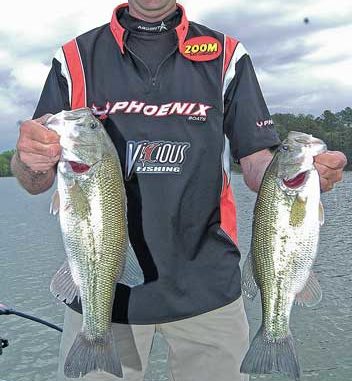
June is the time to catch bass on top at Kerr Lake.
If it’s not the best time of year to catch bass at major North Carolina lakes, June is when fishermen can have the most fun — especially at John H. Kerr (Buggs Island) Reservoir.
That’s because most largemouths leave the shallows after finishing the May spawn. They’re hungry and looking to whack the first baitfish (or lure) that swims past.
And that’s when they like to do it on top — or, more accurately, Buggs Island bass go nuts over topwater lures.
“They’ll move out to the long, flat shoals and chase herring and stuff in June,” said veteran fisherman Jeff Coble, who lived for many years near Palmer’s Point on the lake’s eastern shoreline.
Coble, who has been fishing the lake for years, moved to the area about 20 years ago, working for various boat dealers and manufacturers while developing a successful career as a pro angler.
David Wright of Lexington, while not as well-known nationally, is one of the legendary “Lexington Mafia“ of bass fishing that includes David Fritts, Gerald Beck, Jerry Lohr and himself.
A former high-school teacher, all Wright does now “is tend to his lawn, mow his grass and go bass fishing,” Coble said, chuckling.
Long ago Coble and Wright “made their bones“ as successful tournament anglers, so they know what they’re talking about, especially when it comes to fishing at Kerr.
They both said anglers who visit the lake in early June also will find bass still lurking around the shallows like cops watching the last revelers leave a 24-hour night club.
“They’ll come shallow in the morning,” Coble said. “You can catch ’em with topwater lures then — and into the morning if it’s a cloudy day.”
On 9 a.m. on a normal June day, most bass will have moved to deeper parts of the lake. That’s when Coble and Wright used to shine, catching deep bass on crankbaits.
“But now in June, they’ll be on the long flat points that seem to be more prominent on the lower end of the lake,” Coble said. “The nice thing about it is that most (other anglers) won’t be looking for that kind of (structure).”
Coble said during Jun,e he mostly fishes points from the dam to Grassy Creek (at mid-lake near Clarksville, Va.) or toward Satterwhite Point (in Nutbush Creek) to the south.
“You’ll see these kind of slick sandbars and red-clay points (that hold bass),” Coble said, “and you’ll also pick up (a bass) now and then at solitary stumps.”
On average, Buggs Island bass will weigh 2½ pounds, with a 3- or 4-pounder thrown in for good measure — definitely unlike the good ol’ days just a few years ago.
“You rarely win tournaments fishing deep (in June),” Coble said.
Wright thinks the water level has been a key factor in locating June bass at Kerr.
“The water level is always critical at Buggs because it fluctuates so much,” he said. “Not many lakes I fish fluctuate 19 to 20 feet, as it does up there….
“In June, if the water is high in the bushes, we should have a somewhat normal bite. Years ago, it was a time for a great topwater bite, and you threw buzzbaits. There’d be a lot of shad in the bushes.”
From the time the lake was impounded in 1952, Kerr Lake had plenty of largemouths ranging from six to eight pounds. Slightly more than five years ago, anglers needed to catch 5-fish, 20-pound limits to win tournaments.
Coble’s standard weaponry includes a medium-action, 7-foot Bill Poe custom graphite rod mated to an Ardent 1000 reel spooled with 14-pound-test Vicious co-polymer line.
“(Vicious) is a blended monofilament-fluorocarbon deal,” Coble said. “I don’t like (pure) fluorocarbon that much because it has too much memory.”
“They really throw Lucky Craft Sammys and Zara Spooks,” said Coble, whose favorite colors are shad patterns. “I’ll go darker if (the water) gets muddy, but it’s hard to get muddy at Buggs this time of year,” he said.
On days that portend bright, sunny conditions, as the sun climbs, the topwater bite usually evaporates around 9 o’clock.
“When that happens, you don’t necessarily have to throw a topwater lure, especially up in the day,” Coble said. “That’s when I’ll throw a Zoom Super Fluke.”
Coble usually keeps his boat in deeper water and casts towards the shallows, “but you don’t have to be set up over deeper water. I don’t think it really matters when bass are schooling on the alewives and bluebacks.”
Wright uses 7-foot-long American RodSmith rods mated to Lew’s BB1N reels.
“They quit making (that model reel) about 10 years ago,” he said. “I bought about 30 of them back then. Sometimes when you get something you like, you stick with it.
“I like 10-pound clear Stren monofilament. If I don’t use a Lew’s reel, I use a Quantum E600 PT baitcaster (4.4-to-1 gear ratio). Jeff and I both use Zoom crankbaits — and Zoom plastics.”
During the past few years, the pair — and many Kerr Lake regulars with the best, most-modern equipment — have changed their approach. Bass still are caught close to the bank in the spring, but you’re more likely to find bigger fish on open flats, hanging above featureless bottoms in relatively shallow water.
“It’s the bluebacks (herring) and alewives,” Coble said. “They’ve changed the way people fish up here. It’s definitely true (that) bass don’t relate to cover like they used to. They just swim around, following baitfish.”
Bluebacks and alewifes are species of baitfish that grow larger than threadfin or gizzard shad. Bluebacks and alewifes have been regarded as striped bass favorites, but for some reason, shad numbers have declined.
Coble theorized that herring and alewifes head for the shoreline for their spring spawning cycle, become food for bass, then, as they meander toward deeper water as the summer approaches, bass follow them, staging at relatively shallow water first, then deeper as the baitfish move into open water. In essence, bass have learned to follow alewifes and bluebacks wherever they go.
“Bass now stack up on the shoals where alewifes and bluebacks are,” Coble said. “We’ll catch bass when we see them (on depthfinder screens) on the bottom or see them bust on top.”
One problem Coble related to declining sizes of bass at Kerr Lake also involves alewifes and blueback herring.
“(Bluebacks and alewifes) are predators of small bass, and they eat their eggs,” he said. “I’d say there are still good numbers of 3- and 4-pounders (bass) in the lake, but overall, I think the average sizes of bass are dropping. Whereas in the spring, you used to have to catch 20 pounds of bass to win a tournament, now 15 or 16 pounds will win.”
Wright agreed that fishing has changed at the lake, which famed pro Denny Brauer of Missouri called “my favorite bass lake.”
“The last few year,s the fishery isn’t what it used to be,” Wright said. “Not many people will admit it though.
“I used to go up during the summer from Lexington — and I had High Rock Lake out my back door,” he said. “That’s 130 miles, round-trip. I went to Buggs Island because I could catch 60 or 70 bass, and 10 or 15 would be 4- or 5-pounders.
“But something’s really happened to the lake. There’s three possibilities — the fish got some kind of disease, the big ones died out, or they’re out there in open water, chasing bluebacks that have a tendency to roam over large areas, which means guys just can’t find them as easily.”
Wright said the water level affects where bass are found because it changes where bluebacks and alewives congregate.
“If it drops to 299 (feet above sea level) and there’s hardly any bushes in the water, it seems like the bluebacks spawn on shallow, hard places where you can see the bottom,” he said. “It happens where the bottom turns from blue to brown.
“That’s where the bass herd them and attack them like sharks. They used to never do that, but they do now, and if you want to have a lot of fun catching lots of bass, you need to find those places.
“If you get the right water level and the right wind direction, and you find a place like that, you can catch ’em all day long with a (Zara) Spook. If they’re a little deeper and not on top, you still can catch ’em with a Super Spook about 2-feet down.”

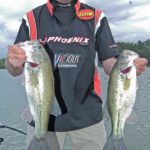
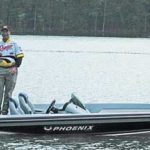
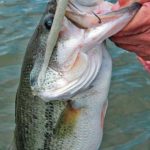
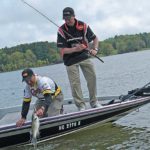




Be the first to comment